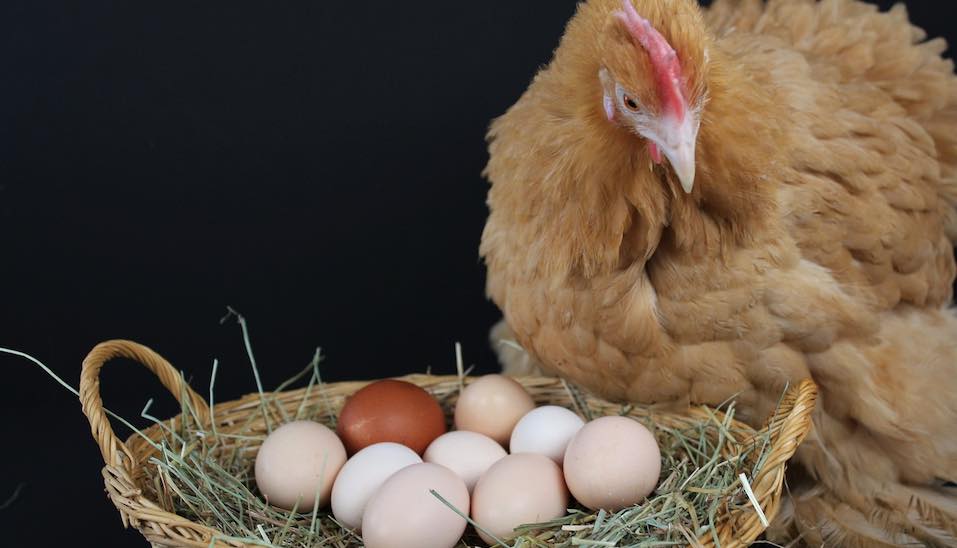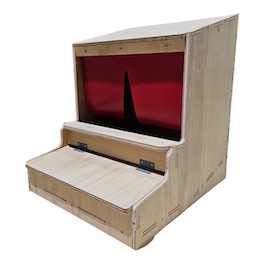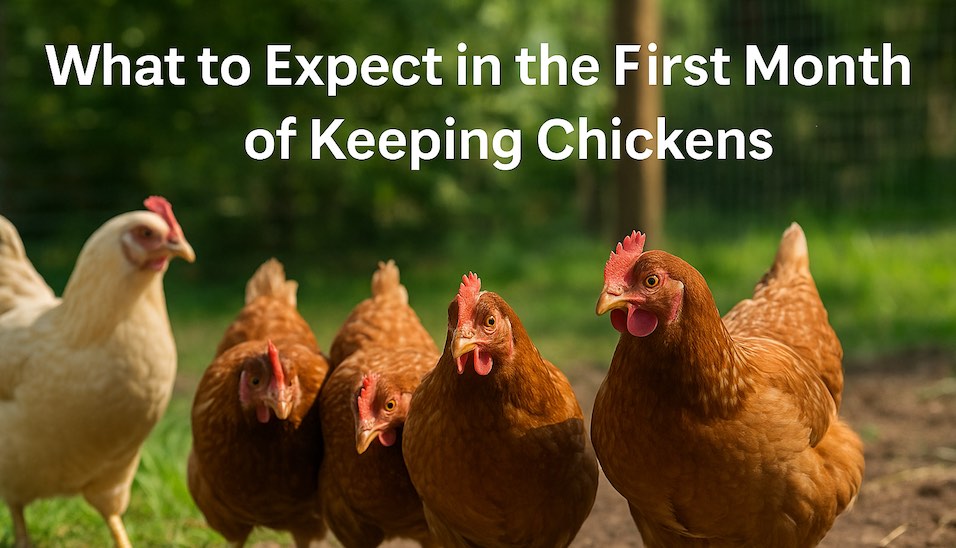How to Choose the Right Nesting Box for Your Chickens
Everything You Need to Know about Nesting Boxes
Chicken nesting boxes are a simple concept – a place for hens to lay their eggs. But choosing the right nesting box can mean the difference between clean, un-broken eggs and dirty, broken eggs.
A good nesting box will also encourage your hens to lay there, instead of in hidden nests all over the backyard!
We go through everything you need to know about nesting boxes, from what type of nesting box is best to how to deal with common problems like chickens laying in the yard or sleeping in the nesting box.
→ See our full range of chicken nesting boxes
Nesting box basics
A common question that new chicken keepers ask is “Do chickens really need nesting boxes?” The answer is yes, absolutely! Hens must have a nesting box.
Chickens prefer a secure, dark, private place to lay their eggs. If you don’t provide enough suitable nesting boxes, your chickens will choose to lay elsewhere.
Hidden nests are often difficult to locate and can even lead to unwanted chicks, if you have a rooster!
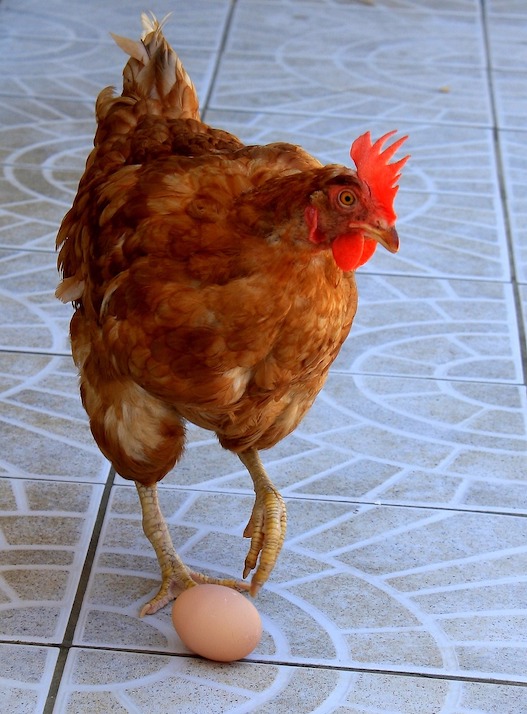
Chickens will lay in gardens or under buildings, because these places are quiet and dark. But if there is no other choice, a hen will even lay on the chicken coop floor.
Floor laying, especially, can cause all sorts of problems:
- Eggs become contaminated with droppings
- Exposed eggs are easily broken
- Exposed and broken eggs encourage egg-eating among your flock, a terrible habit which is almost impossible to break once established
- During laying, the hen’s vent is exposed, and other birds may peck this tender area causing injury and leading to cannibalism
Having secure, private nesting boxes is very important for laying hens. We added handy privacy curtains in our roll-away nesting boxes for this exact reason.
At what age do chickens need nesting boxes?
Young hens will often start to sit in nesting boxes, “practicing” laying, a week or so before they produce an actual egg.
Make nesting boxes available once your hens are around 15 weeks of age.
How many nesting boxes do you need?
No matter how many nesting boxes you have, hens tend to use the same one or two. But having plenty of nesting boxes for your flock can prevent egg breakages and stop chickens from laying in other places.
As a general rule, chickens need one nesting box for every three hens. This means that 2 nesting boxes are enough for 6 chickens. Always have at least 2 nesting boxes, even if you only have 2 hens!
Read more about how many nesting boxes do you need.
What makes a good laying box?
There are many different types of boxes available.
But the best nesting boxes have:
- A roof
Although chickens will lay in open nesting boxes, which are common in older chicken coops, a roof is usually preferred to create a cosy nest and prevent other birds from disturbing laying hens. A roof is also necessary to protect nesting boxes from poop if they are near roosts.
- Dim light and privacy
Although some chickens will happily share a nesting box, most hens like to lay their eggs somewhere private and dark. Dim light also discourages egg eating and vent pecking.
- Soft nesting material
Chickens do enjoy creating a cosy nest, but the main purpose of nesting material is to cushion the eggs. If eggs fall onto a hard surface, they can crack or break, which is wasteful and can lead to egg-eating!
- A lip
A lip on the edge of the nesting box is important. Not only does this keep eggs from rolling out, it stops your hens from scratching out the nesting material while they are getting comfortable.
- Just enough room
Nesting boxes should be big enough to accommodate one hen comfortably. For most chickens, a 30 cm x 30 cm nesting box is about the right size. If the nesting box is too large, it can encourage sharing which leads to broken eggs and fights. Chickens may also choose to lay elsewhere if the nesting box isn’t cosy enough!
- Suitable access
Nesting boxes should have steps or a ramp for easy access. Chickens will struggle to fly from the ground into a smallish nesting box opening. Steps also allow hens to check whether the nesting box is occupied before going in.
A great addition to the chicken coop is a Roll Away Nesting Box.
Roll Away Nesting Boxes have a sloped floor that directs eggs into a secure, separate compartment. This keeps eggs cleaner, because the eggs aren’t being stepped on by subsequent chickens.
Roll Away Nesting Boxes prevent breakages and store eggs securely until you can collect them. If you work during the day and only collect eggs in the evening, a Roll Away Nesting Box is the best way to prevent broken or cracked eggs and egg-eating. And if you have an egg-eating hen, then a Roll Away Nesting Box is a must!
External access is another nesting box feature that some chicken keepers prefer. Being able to collect eggs from outside of the coop keeps shoes clean and can be a good way of encouraging timid children to be involved with the chickens.
Choosing the best box for your coop
All chook boxes should be secure, cosy and private.
If you only collect eggs once a day, we recommend a roll away option to prevent problems like breakages and egg-eating.
If you don’t need to protect eggs from breakages, there are all sorts of great DIY nesting box options. Just remember to ensure the nesting box is private and cosy, and that it has a lip to stop eggs and nesting material falling out.
Most DIY nesting boxes need additions in order to provide access for your hens and prevent chickens from roosting on top.
Some pre-made DIY nesting box options include:
- Pet carriers
- Grass catches from mowers (only use plastic grass catchers, not material ones)
- Sets of drawers
- Shelves
- Baskets
- Plastic tubs
- Cardboard boxes (replace regularly)
- Unused kitty litter trays, especially the hooded kind
- Milk crates
- Buckets
- 20 L drums
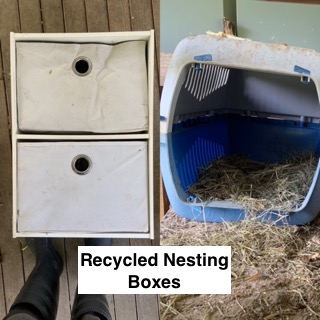
Many traditional nesting boxes are simply built of wood.
We also manufacture single chicken and twin hole tradional nesting boxes out of durable 12mm hardwood ply in our Townsville warehouse if you're looking for a ready-made options! We ship them everywhere in Australia.
→ See all nesting boxes in our store!
The best chicken nesting materials
Chickens certainly enjoy making a cosy nest. But the main purpose of chicken nesting materials is to cushion eggs and prevent breakage!
All nesting boxes need a cushioning liner. Many chicken keepers like to provide a more traditional nesting material on top of the liner as well, but this is optional.
Nesting box lining
The best option for lining a nesting box is commercial nesting material. This plastic matting is specifically designed to prevent eggs from breaking and is easy to clean, preventing parasites. Other nesting box linings include egg mats and nesting pads.
For DIY options, you could use pieces of yoga mat. We also like a thick layer of newspaper, but it should be replaced and composted every time you clean the coop. Avoid cloth nesting box linings, such as carpet, as these harbour parasites.
Removable lining that is easy to clean is the best option.
Nesting materials
Most chicken keepers still prefer to provide some nesting material on top of the nesting box lining. Use a soft material like chopped straw and avoid irritants like sawdust and wood shavings.
Adding Nesting Herbs can make the nesting box more appealing for your hens. But always use dried herbs, not fresh, as fresh herbs can become mouldy.
Nesting box installation
Of course, once you have chosen the best nesting box for your chicken coop, the next question is where to put it.
Even the best nesting box in the world can be ignored by your chickens if it is installed in an unsuitable spot.
Where to put your nesting box?
Nesting boxes can go anywhere in the coop.
They should always be inside, to protect hens from predators, and sheltered from the weather. Choose somewhere that is cool in summer and away from drafts.
It is best to put chicken nesting boxes somewhere cosy, quiet and dim. So right next to high-traffic areas like the Feeders and door isn’t ideal. If there isn’t a quiet corner in your coop, then nesting box curtains will be a must-have!
In many chicken coops, the nesting boxes are tucked underneath the roosts. This saves space but can encourage parasites to take up residence in the nesting boxes, which often causes chickens to lay elsewhere. If your nesting boxes are underneath the roosts, always use a droppings board to stop the nesting boxes being contaminated with poop!
It is fine to stack nesting boxes on top of one another.
How high should nesting boxes be from the floor?
Nesting boxes can be placed on floor level, but chickens tend to prefer nesting boxes that are slightly raised. We recommend that nesting boxes are 30 cm to 1 m above floor level.
Raised nesting boxes provide some protection from predators and keep eggs and nesting materials cleaner. Putting nesting boxes above floor level also decreases traffic in the nesting boxes, meaning hens are undisturbed when laying and less likely to walk on the eggs.
Even low nesting boxes should have a step or ramp leading up to them. This prevents foot and leg injuries like bumblefoot.
Should roosts be higher than nesting boxes?
Chickens naturally want to roost as high up as possible. For this reason, roosts should always be higher than nesting boxes, or you will find your chickens roosting in or on the nesting boxes.
It is not good for chickens to roost in or on nesting boxes for two reasons:
- Nesting boxes become contaminated with poop each night, which leads to dirty eggs
- There is a higher incidence of parasites in the nesting boxes, which can spread disease and cause chickens to lay elsewhere
Nesting box use and maintenance
Once you have a good quality box, the next step is maintaining it.
Maintaining your nesting box by keeping it clean and parasite-free is essential for encouraging your chickens to lay there.
Cleaning the boxes
Poops should be removed from nesting boxes as soon as possible, cleaning or replacing all soiled materials, including nesting box lining and the box itself.
This is important for keeping eggs clean.
Additionally, nesting boxes should be cleaned thoroughly whenever you clean the coop – ideally every week or two.
Here are the steps for cleaning a nesting box:
- Remove all nesting materials including lining.
- Wash the box, and lining if applicable, with soap and water. Rinse and allow to dry.
- Disinfect the nesting box, and lining if applicable, and allow to dry completely.
- Treat the nesting box for parasite prevention by sprinkling with Diatomaceous Earth or Poultry Dust, ensuring you treat any cracks.
- Replace nesting box liner and nesting materials.
- For extra comfort, add Nesting Herbs for a fresh, relaxing scent.
How to encourage chickens to use a nesting box
Most hens will naturally use the nesting box to lay eggs, if it is suitably quiet and private.
New layers will copy older hens, and most experienced hens are smart enough to recognise a nesting box even if it has been moved or changed.
You can encourage your hens to lay in the box by placing a fake egg in the nest. A fake egg is particularly useful for first-time layers, as they may not know where to go if there are no older laying hens in the flock.
Ceramic and rubber eggs are available for this purpose, although a golf ball or suitably-sized stone can be equally effective. Do not use a real egg, even a hard-boiled one, as it only takes one broken egg to cause egg-eating!
Keeping chickens in the coop until midday can also encourage nesting box use, particularly if your hens have gotten into the habit of laying in the garden or yard. But because hens don’t strictly lay in the mornings, this method doesn’t always work.
Chicken nesting box trouble shooting
Below, we go through the most common nesting box blues and provide solutions. A lot of the most common nesting box issues can be solved by using a Roll Away Nesting Box!
Help! My chickens aren’t using the nesting box
There can be many reasons why chickens might choose not to lay in the nesting boxes. Some common reasons why chickens aren’t laying in the nesting boxes include:
- Parasites in the nesting boxes, like lice and mites
- Predators, such as rodents, foxes and snakes, around the nesting boxes or coop
- Dirty nesting materials or poop in the nest
- Broody hens monopolising a preferred nesting box
- A bully guarding the nesting boxes and preventing lower ranked hens from accessing them
- Too much light or noise in the nesting boxes
- Situating the nesting boxes in an area with too much traffic, such as near the coop door or Feeders
- Not enough nesting boxes for the number of hens
- Being broody, which can make some hens seek a more private nest
- Nesting boxes that are too big or too small
- Not knowing where the nesting box is (mostly new layers)
Of course, some hens are also just picky and like to lay where they like to lay, even if the nesting boxes provided are perfect! Unfortunately, hens like to lay in the same nest as others, so if one hen decides to make a nest somewhere outside of the coop, it is common for other hens to use the new nesting spot too!
You can encourage your chickens to use the nesting box by:
- Cleaning the nesting box
- Replacing nesting materials
- Treating the nesting box and coop for parasites
- Removing and treating broody hens
- Adding privacy curtains to the nesting box
- Moving the nesting boxes to a quieter spot
- Adding a fake egg
- Keeping chickens in the coop until midday for a week or so, until they get used to laying in the nesting boxes
Read more about why chickens are not using the nesting boxes
Why are my chickens all using the same nesting box?
Chickens are naturally social creatures and tend to copy one another, including in choosing a nest.
This means all of your hens might want to use the same nesting box, even though there are other, equally nice, nesting boxes available. It also means that once one hen makes a nest under a bush in the garden, their friends will also want to try this new innovation!
Having enough nesting boxes can help prevent your chickens from all using the same nesting box. Adding a fake egg to some of the unfavored nesting boxes can also help. But there is not much else you can do if your hens all want to lay in the same spot, which is a shame because nesting box sharing often leads to dirty and broken eggs!
How to stop chickens from sleeping in the nesting box
Hens sleeping in the nesting box are a problem because they poop in there, and thus cause dirty eggs and parasites.
There are a few reasons why hens might be sleeping in nesting boxes:
- The nesting boxes are higher up than the roosts – chickens always sleep as high up as they can, so roosts should be higher than nesting boxes
- The roosts are unsuitable or uncomfortable – click here to see if your roosts might be the problem
- There are not enough roosts for the flock – some bullies may require a whole roost to themselves!
- There are mites in the coop – check with a torch at night and treat the coop for parasites
- The hen is being bullied, is unwell, or has foot or leg issues – check that a bully isn’t keeping others from roosting. We also recommend providing at least one platform roost that is high up but easy to access. This allows older hens and those with foot issues to roost and stops them preferring the nesting boxes.
If there doesn’t seem to be a reason for hens to prefer to roost in the nesting boxes, try closing off the nesting boxes in the late afternoon.
Can chickens roost on top of nesting boxes?
Chickens do like to roost on top of nesting boxes, especially if the top of the nesting box is at a similar height to the roosts.
It is not the end of the world if your hens roost on top of the nesting boxes. But this can lead to poop in and on the nesting box, and increases the chance of parasites in the nesting box too!
Most commercial nesting boxes have sloped roofs to prevent this problem. But the use of a droppings board on top of the nesting boxes can also be a simple solution if your chickens insist on roosting on the nesting boxes.
What to do about parasites in the nesting boxes
Parasites in the nesting boxes can be a real problem. In fact, a mite or lice infestation can be a reason why your hens are not using their nesting boxes at all.
For this reason, we recommend cleaning nesting boxes regularly and replacing nesting material. Using Diatomaceous Earth or Poultry Dust in the bottom of the nesting box will also prevent parasites.
What to do about broody hens in the nesting box
Broody hens can be a real problem. They take up nesting box space, usually in the favourite box, and cause squabbles. Sharing nesting boxes tends to lead to broken and dirty eggs, and broodies may attack you when you collect the eggs too.
If you are letting a hen sit on eggs, put her in a separate nesting box and cage. And if you aren’t going to let her sit, act immediately to cure her of broodiness.
Broody behaviour seems to be contagious, and it can also be prompted by a nest of eggs. Privacy curtains and Roll Away Nesting Boxes can help decrease problems with broody hens!
Egg eating chickens
Egg eating is a terrible habit in laying hens, and can be very hard to curb once it starts. The best thing you can possibly do is prevent your hens from learning to eat eggs in the first place. Hens tend to begin egg eating for one of 3 reasons:
- They pecked an egg which broke and discovered how delicious it was
- They broke an egg in the nesting box, or came across a broken egg, and discovered how delicious it was
- Someone fed them recognisable eggs, e.g. with the shell and not broken up
If you have an egg eating hen, the only solution is a Roll Away Nesting Box, so that eggs are out of the reach of hens once they are laid.
We also like Roll Away Nesting Boxes because they prevent breakages in the nesting box and curious pecking, reducing the likelihood of an egg eating habit developing.
Thin-shelled eggs, which are indicative of a calcium deficiency, can also cause egg eating because they can be accidentally broken by curious pecking or nesting box movement. Ensure your hens are getting enough calcium!
Dirty eggs in the nesting box
Dirty eggs can have a few different causes:
- A dirty chicken coop
- Dirty nesting boxes
- Sick hens
- High traffic
Ensure your nesting boxes are high up and chickens aren’t sleeping in them. Clean and replace nesting materials and lining whenever there is a poop. Keep the coop clean and check for chickens with dirty bums, and treat those hens for illness.
The more hens using a nesting box, the more likely they are to track in poop on their feet, dirtying eggs and nesting materials, so also ensure you have enough nesting boxes and get a Roll Away Nesting Box so that eggs are protect from being dirtied by subsequent hens.
Broken eggs in the nesting box
Broken eggs in the nesting box usually occur because eggs are fragile. Older hens, particularly those with a calcium deficiency, tend to lay thinner-shelled eggs which are particularly prone to breakage.
Chickens sharing nesting boxes, squabbling over a nesting box, or using a nesting box that has an egg in it already, all make breakage more likely. So does having to remove eggs from under a broody hen who is not cooperative!
If broken eggs are a problem in your nesting box ,ensure your girls are getting enough calcium. Also make sure you have enough nesting boxes, so there are less squabbles and less sharing.
Broken eggs are most common where eggs are only collected late in the day. The longer eggs wait for collection, the more likely they are to be accidentally broken by a hen in the nesting box.
So if you are unable to collect the eggs regularly, consider a Roll Away Nesting Box that will keep eggs safely hidden away and protected from breakage.
→ See our full range of chicken nesting boxes
Do you have a nesting box question that we haven't answered? Get in touch!
Happy chicken keeping!
Rachael at Dine-A-Chook Australia


